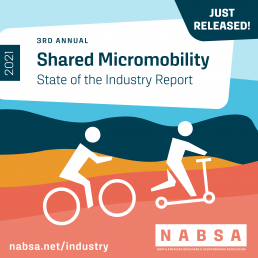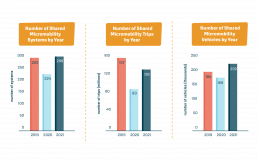NABSA’s Third Annual Industry Report Shows Shared Micromobility Coming Out of the Pandemic Better Than it Went In

- Today, NABSA releases the third annual Shared Micromobility State of the Industry Report for North America – the only report of its kind tracking the trends, growth, and success of shared micromobility across North America.
- Shared micromobility is coming out of the pandemic better than it went in, with systems in at least 298 cities and 232,000 vehicles in operation – both higher than 2019 pre-pandemic numbers.
- At least 128 million trips were taken on shared micromobility across North America in 2021.
- Electric-assist shared micromobility thrived in 2021. The number of trips taken on e-bikes increased from 9.9 million to 18.8 million, and trips on e-scooters accounted for 49% of the total trips taken on shared micromobility.
Today, NABSA is pleased to present the third annual Shared Micromobility State of the Industry Report for North America.
The report’s role as an advocacy tool is more vital than ever as leaders and policymakers take steps to develop policies and solutions that mitigate climate change, improve transportation equity and access, and encourage the use of sustainable modes of travel. The 2021 State of the Industry Report shows shared micromobility’s success as a climate action tool, facilitator of mode shift, and a transportation equity and access solution that improves public health, local economies, and existing transportation ecosystems. The report also highlights how some public agencies have already integrated shared micromobility into transportation, climate, equity, and public health policies as examples of how more agencies at all levels of government can utilize shared micromobility toward these public goals.
“In this important time globally, as we face climate, equity, and transportation challenges, shared micromobility is a tool for policymakers and communities to utilize towards creating the transportation networks that serve people, communities, and our planet better,” said NABSA Executive Director Samantha Herr. “By quantifying and tracking the benefits and impact of shared micromobility, and demonstrating year-over-year success and growth, the Shared Micromobility State of the Industry Report is an important tool in our advocacy work.”
The report demonstrates the incredible resilience of shared micromobility by tracking ridership levels and trends through the COVID-19 pandemic as it continued through 2021. At least 128 million trips were taken on shared micromobility in 2021, a significant increase from 2020, and monthly ridership rebounded quickly and began exceeding 2019 levels mid-year. In addition, the number of vehicles in operation and cities with shared micromobility systems exceeded pre-pandemic levels, at 232,000 and 298, respectively.

Data in the report also shows that 37% of shared micromobility trips replace a car trip. By replacing car trips in 2021, shared micromobility offset approximately 54 million pounds of CO₂ emissions. By replacing car trips and generating new trips, North Americans gained an estimated 15.5 million hours of additional activity. Sixty-three percent of riders also reported that they use shared micromobility to connect to transit. In these ways, the State of the Industry Report clearly demonstrates how shared micromobility across North America connects millions of riders to essential services, public transportation, and other important destinations while helping cities and municipalities to meet equity, access, climate, and public health goals.
The report also shows that more steps were made toward diversity, equity, and inclusion in shared micromobility in 2021. According to agencies and operators who responded to workforce diversity questions, 81% of respondents stated that diversity is part of every hiring conversation, and 71% reported that their staff had completed cultural competency or diversity training – increases of 10% and 16% from 2020 respectively. When compared to Census data, the report also demonstrates better representation of People of Color and very low-income riders in 2021 than in 2020.
New this year, the State of the Industry Report showcases developments and trends in policy that support shared micromobility at all levels of government. The report tracks e-bike and e-scooter codification across US states and Canadian provinces, to what extent agencies have incorporated shared micromobility into transportation, climate, health, and equity policies, and provides case examples of how different types of policies at all levels of government can support shared micromobility as a tool to advance climate, equity, health, and transportation goals.
The 2021 report features another new section that provides insights into the roles and relationships associated with integrating shared micromobility with public transit. Responses to the agency survey indicated that more than half of transit agencies are involved in station planning, and 37% of transit agencies co-promote or co-market shared micromobility alongside their services.

The report also captures the growing popularity and demand for electric shared micromobility. E-bikes were present in 50% of cities with a bikeshare system – an increase of 6% from 2020 and 22% from 2019 – and e-bikes were ridden approximately 36% more than regular pedal bikes.
Additionally, the percentage of cities with shared e-scooter systems increased from 58% in 2020 and 52% in 2019 to 64% in 2021. Shared e-bikes and e-scooters accounted for about 81 million of the total trips taken, with the number of e-bike trips nearly doubling to 18.8 million compared to 2020. Overall, electric shared micromobility vehicles were the most deployed, representing 68% of the total number of vehicles in operation.
“Shared micromobility enables one of the most efficient ways to make short trips and it’s great to see that it continues to gain a foothold in North America,” says Lina Fedirko of the ClimateWorks Foundation, which supported the report. “The near doubling of trips on e-bikes, from 9.9 million in 2020 to 18.8 million in 2021, mirrors the appetite for e-bikes that we’re also seeing in Europe. I think for people that are used to traveling at fast speeds via cars or transit, e-bikes are emerging as an appealing bridge mode of transport that feels more personal, active, enjoyable, and definitely climate-friendly.”
The third annual Shared Micromobility State of the Industry Report reaffirms shared micromobility’s resilience, growth, and impact over the last three years in communities across North America, and points to the even greater impact on climate, equity, health, and transportation goals that shared micromobility could have with more policy that supports its growth.
NABSA worked with Toole Design and the University of California Berkeley Transportation Sustainability Research Center to help develop the report. The report is composed of survey results, statistics gathered from performance reports released by shared micromobility systems, and data from GBFS. In addition to the metrics shared above, more information about COVID-19 pandemic resilience, mode shift, economic benefits of shared micromobility, equity and access programs, trip and vehicle trends, system statistics by size, operating characteristics, shared micromobility and public transportation, and shared micromobility in and advancing policy can be found in the report.
Both an English and Spanish version of the report is available for download at nabsa.net/industry.
In addition to the annual Shared Micromobility State of the Industry Report, NABSA convenes an Annual Conference. The NABSA Annual Conference is the only shared micromobility-focused conference globally, and brings together shared mobility leaders, practitioners, operators, and equipment and technology providers to actively shape the future of shared micromobility. This year’s conference will be held on October 25-27th in Guadalajara, Mexico. More information about the conference and registration can be found at nabsa.net/2022conference.
